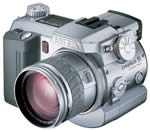The Death of the Bridge Camera
 PMA 2006: The first ever digital camera that I bought was the Minolta DiMAGE 5 bridge-style camera, so-called because it “bridged” the gap between a smaller compact digital camera and a larger digital SLR. Now it seems that the bridge camera has become something of a dying breed, at least for those manufacturers with DSLRs in their product range.
PMA 2006: The first ever digital camera that I bought was the Minolta DiMAGE 5 bridge-style camera, so-called because it “bridged” the gap between a smaller compact digital camera and a larger digital SLR. Now it seems that the bridge camera has become something of a dying breed, at least for those manufacturers with DSLRs in their product range.
Last week’s PMA show in Orlando, Florida, saw no less than 90 new digital cameras announced for 2006. Conspicuous by their small number were the bridge style cameras – only Kodak, Panasonic and Sony announced new models that fall into this category. What do these three companies have in common? None of them have any DSLR cameras (not yet anyway). If you add Fujifilm into the mix (the S3 Pro has very little market share), then it is clear that the bridge camera is only supported by companies that have virtually no presence in the DLSR market.
On the other hand, those manufacturers who do have a strong DSLR line-up have quietly removed bridge cameras from their 2006 range. Canon has confirmed that their very popular G-Series cameras are no more, and there was no sign of a new Pro Shot model at PMA. Olympus has officially discontinued their C-8080, C-7070 and C-5060 cameras, and Nikon only have a couple of older models that fit the bridge description. All of these companies were busy introducing a slew of more compact digicams at PMA, or promoting their latest DSLRs.
So it seems that, for some manufacturers at least, the bridge camera has been squeezed out at both ends – from below by the compact digicams, which are offering ever more advanced functionality and zoom ranges in a smaller form factor, and from above by the DSLRs, which are becoming ever cheaper. There is simply more money to be made by selling digital SLRs, with the many expensive add-ons in the form of lenses and flashguns, whilst compacts can accommodate the majority of people who don’t want the bulk of a DSLR. For the likes of Canon, Nikon and Olympus, bridge cameras actually compete with their most profitable products (DSLRs), rather than complement them, hence their gradual removal.
So what does this mean for you, the consumer? Well, if the current trend continues, it will ultimately lead to a lot less choice, especially if the likes of Sony and Panasonic go down the same road and phase out their bridge camera ranges. In a few years time, I predict that you will be able to buy either a compact digital camera, or a DLSR, with no in-between. The bridge camera, with its unique combination of SLR-like handling, no sensor dust issues, versatile focal length and advanced functionality, could disappear forever, not because people have stopped buying them, but because the camera companies have simply stopped selling them. A quiet revolution is happening, one that isn’t being driven by the people.
